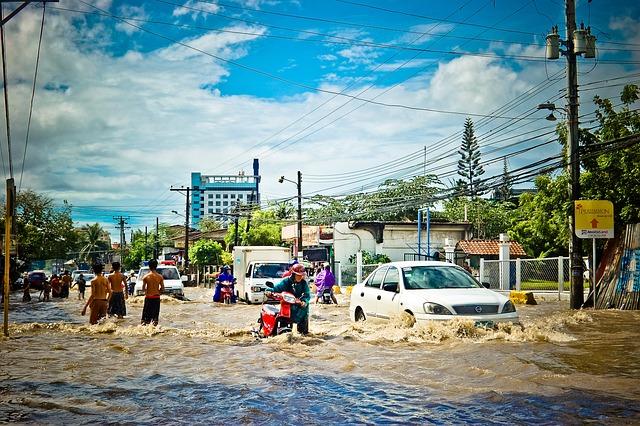In recent weeks, East Africa has faced a devastating onslaught of floods, with Kenya, Tanzania, and Burundi bearing the brunt of nature’s fury. The heavy rains, exacerbated by climate change and altered weather patterns, have led to rising river levels, landslides, and widespread displacement of communities. These catastrophic events have not only disrupted lives but have also overwhelmed local infrastructure and strained resources,posing significant challenges for disaster response efforts.As rescue teams work tirelessly to assist those affected, the situation highlights not only the immediate impact of weather-related disasters in the region but also underscores the urgent need for comprehensive strategies to mitigate the effects of climate change in vulnerable areas. This article delves into the latest developments, the humanitarian response, and the broader implications of these floods on the communities impacted across East Africa.
Impact of Unprecedented Flooding on Communities in Kenya,Tanzania and Burundi
The recent catastrophic flooding in the region has left communities grappling with the disastrous aftermath.Numerous villages have been submerged, leading to loss of homes and infrastructure, while local economies are on the brink of collapse.The extensive damage to critical services has resulted in severe health risks, including the spread of waterborne diseases. Residents are facing dire challenges such as:
Contaminated water supply: Many water sources have been polluted,making it unsafe for consumption.
Displacement of families: Thousands have been forced to evacuate and seek shelter in temporary camps.
Loss of crops and livestock: Floodwaters have destroyed fields and displaced livestock, threatening food security.
As recovery efforts begin, grassroots organizations and international aid agencies are mobilizing resources to assist affected populations. The importance of community resilience and preparedness has never been more apparent, driving conversations around lasting practices and improved infrastructure. in addressing these pressing challenges,stakeholders are focusing on:
Strengthening early warning systems: Enhanced forecasting can help predict floods more accurately.
Building flood-resistant infrastructure: Investment in roads and drainage systems that can withstand extreme weather is crucial.
Promoting community education: Raising awareness about sustainable agricultural practices and risk management.
Impact Area
Current Status
Required Action
Infrastructure
Severe damage reported
Immediate repair and assessment needed
Health Services
Increased disease outbreaks
Establish mobile health units
Food security
Loss of crops
Seed distribution and support for farmers

Government Response to the Crisis: Actions Taken and Challenges Faced
The recent flooding crisis in Kenya,Tanzania,and Burundi has prompted a swift response from national and local governments,as well as international organizations. Authorities have mobilized emergency services to assist in rescue operations and provide humanitarian relief to those affected. Key actions taken include:
Emergency Declarations: Governments have declared states of emergency in the moast affected regions, facilitating quicker allocation of resources.
Evacuation Plans: Measures have been implemented to evacuate residents from high-risk areas to safer locations.
Distribution of Aid: Relief teams are actively distributing food, clean water, and medical supplies to vulnerable populations.
Infrastructure Assessment: Engineers are evaluating damage to roads and bridges to ensure safe passage for aid deliveries and emergency services.
Despite these commendable efforts, significant challenges persist. The scale of the flooding has overwhelmed local capacities, and many areas remain inaccessible due to blocked roads and damaged infrastructure. Additionally, logistical issues hinder the timely delivery of aid, compounded by poor communication networks in some regions. To illustrate these difficulties, the table below highlights the current state of affected regions and their needs:
Region
Injured
displaced
Immediate needs
Kenya
200+
5,000+
Food, shelter
Tanzania
150+
3,000+
Clean water
Burundi
100+
2,500+
Medical supplies

Emergency Aid Efforts: Local and International Support Initiatives
The recent floods in Kenya, Tanzania, and Burundi have prompted both local communities and international agencies to mobilize resources swiftly to alleviate the suffering caused by the disaster. Relief efforts are underway, characterized by quick responses from non-governmental organizations (NGOs), government bodies, and the international community. Key organizations involved in the aid efforts include:
World Food Programme (WFP)
International Federation of Red Cross and Red Crescent Societies (IFRC)
United Nations Children’s Fund (UNICEF)
On the local front, community-based initiatives are also making a significant impact. Grassroots organizations are banding together to provide immediate assistance to those displaced by the floods. Support initiatives are focusing on various aspects, including:
distribution of essential supplies such as food, water, and blankets
Emergency medical assistance to prevent the outbreak of diseases
Temporary shelter solutions for displaced families
Organization
Type of Support
Location
WFP
Food Assistance
Kenya
IFRC
Medical Supplies
Tanzania
UNICEF
Child Protection Services
Burundi

Long-term Solutions: Addressing Climate Change and Infrastructure Resilience
The recent floods that have devastated parts of Kenya, Tanzania, and Burundi highlight the urgent need for sustainable strategies to combat climate change and strengthen infrastructure resilience.as communities grapple with the immediate impacts of these disasters, it becomes vital to implement long-term measures that can mitigate future risks. Effective approaches may include:
Enhanced Urban Planning: Integrating green spaces and better drainage systems to handle excess rainfall.
Disaster Preparedness Programs: Educating communities on flood risks and emergency response techniques.
Investment in Climate-Resilient infrastructure: Developing roads and bridges that can withstand extreme weather events.
Restoration of Natural Ecosystems: Reinforcing wetlands and mangroves to improve natural flood defenses.
Collaborative efforts among governments,NGOs,and local communities can drive these initiatives forward. According to recent studies, addressing the infrastructure gaps and investing in renewable resources are critical components for reducing vulnerability to climate change impacts. Effective solutions will not only protect lives and property but also contribute to economic stability in the region. The table below summarizes key infrastructure investment areas and their expected benefits:
Investment Area
Expected Benefits
Flood Control Systems
Reduced severity of flooding impacts
Renewable Energy Projects
Lower carbon emissions and energy costs
Community Health Facilities
improved public health responses during disasters
Affordable Housing Initiatives
Increased safety and stability for vulnerable populations

Health and Safety Risks: The Aftermath of Flooding on Public Health
The recent flooding in Kenya, Tanzania, and Burundi poses a significant threat to public health, exacerbating the already critical health challenges faced in these regions. As the floodwaters recede, they leave behind stagnant pools, which become breeding grounds for mosquitoes, increasing the risk of diseases such as malaria and dengue fever. Moreover, the contamination of water supplies with flood debris and sewage leads to a surge in waterborne illnesses, including cholera and typhoid. Vulnerable populations, notably those in refugee camps and impoverished areas, are at heightened risk due to limited access to medical care and sanitation facilities.
Addressing these health risks requires urgent action and cooperation among government agencies, NGOs, and community leaders. Key measures include:
Distributing clean drinking water to affected communities to prevent contamination and disease outbreaks.
Implementing mosquito control measures to reduce breeding sites and protect public health.
Providing vaccinations against diseases that could spike due to flooding.
Educating communities on hygiene and sanitation practices to mitigate health risks.
Investments in health infrastructure are essential to bolster resilience against future flooding events. The following table summarizes some key health indicators in the affected regions pre- and post-flooding:
Indicator
Before Flooding
After Flooding
Malaria Cases (monthly)
500
1,200
Cholera outbreaks
2
8
Access to Clean Water (%)
70%
40%

Looking Ahead: Strategies for Future Flood Mitigation and Prevention
as communities in Kenya, Tanzania, and Burundi grapple with the devastating impacts of recent floods, it is imperative to explore innovative strategies for effective flood mitigation and prevention. Integrating traditional knowledge with modern technology can greatly enhance resilience. Local populations possess invaluable insights about weather patterns and terrain that can guide more informed decision-making. Harnessing Geographic Information Systems (GIS) and remote sensing technologies can further enable the identification of vulnerable areas and aid in planning and resource allocation.
Moreover,fostering collaborative efforts among governments,NGOs,and community stakeholders is crucial. Implementing effective land use planning and sustainable agricultural practices can reduce the risk of flooding. Key strategies include:
Establishing green spaces to absorb excess rainwater
Constructing flood barriers and retention basins
Enhancing drainage systems to improve water flow
Promoting reforestation to maintain natural water absorption
Furthermore, investment in community awareness programs will empower citizens with knowledge about flood risks and emergency preparedness, creating a robust safety net in the face of natural disasters.

Wrapping Up
the recent floods that have devastated large areas of Kenya,Tanzania,and Burundi highlight the ongoing challenges posed by extreme weather events and climate change in the region. As communities grapple with the immediate aftermath,including loss of homes,livelihoods,and even lives,the need for robust disaster management strategies and improved infrastructure becomes increasingly clear. Governments,humanitarian organizations,and local communities must come together to provide relief and implement long-term solutions to mitigate the effects of future flooding. the resilience of the affected populations in the face of such adversity will be crucial as they begin the arduous process of recovery and rebuilding. The situation remains fluid, and ongoing support from both local and international agencies will be essential in addressing the needs of those impacted by this natural disaster. As we continue to monitor developments, it is vital to recognise the importance of sustainable practices and preparedness in safeguarding against future environmental challenges.
Author : Charlotte Adams
Publish date : 2025-02-26 03:43:00
Copyright for syndicated content belongs to the linked Source.
—-
Author : africa-news
Publish date : 2025-02-26 04:22:00
Copyright for syndicated content belongs to the linked Source.